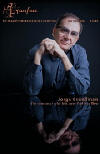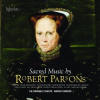Texte paru dans: / Appeared in:

Fanfare Magazine: 35:5 (05-06/2012)
Pour
s'abonner / Subscription information
Les abonnés à Fanfare Magazine ont accès aux archives du
magazine sur internet.
Subscribers to Fanfare Magazine have access to the archives of the magazine
on the net.
Hyperion
CDA67874

Code-barres / Barcode:
0034571178745
Consultez toutes les évaluations recensées pour ce cd
~~~~ Reach all the evaluations located for this CD
Little is known of the life of Robert Parsons (c.1535–72). He was sworn in on October 17, 1563, as a Gentleman of the Chapel Royal, a prestigious appointment. In 1567 he received a Crown lease good for 21 years to three rectories near Lincoln. He drowned at Newark upon Trent, as noted in the Cheque Book of the Chapel Royal; William Byrd was appointed soon thereafter in his place. One epitaph survives in partbooks a decade later, prepared by the copyist Robert Dow, though not necessarily written by him. A Martial-like Latin couplet, when translated into English it runs, “Parsons, you who were so great in the springtime of life, how great you would have been in the autumn, had death not come.”
The rest is inference, and not much of that, either. He may have been a choirboy, as he served as assistant until 1561 to Richard Bower, Master of the Children Choristers at the Chapel Royal, and some of the songs from the choirboy plays were composed by him. It’s also thought that he may have been traveling from Lincoln to Newark to visit his properties at the time of his death, though why he would continue on during the flooding of the Trent remains a mystery. Some commentators have suggested that he may have been a Roman Catholic sympathizer or part of the communion, as his settings of Latin texts are more expressive than his English-language ones associated with the Anglican Church (as this album readily demonstrates). However, it’s possible that this was a result of stylistic change over time, since Parsons’s Latin compositions follow his English ones chronologically, appearing under the reign of Mary I—and little enough survives of either to make a reasonable conclusion possible. Several of the Latin works are incomplete; the Peccantem me quotidie is missing its tenor book, for example, while roughly half the treble part is missing from the Magnificat. Various editorial reconstructions have allowed the performance and recording of these works, whose loss would be regrettable.
For whatever the facts may be surrounding Parsons’s life, beliefs, and activities, his sacred music is of high quality. From first to last, it revels in the display of contrapuntal craft that English composers held in common with the Flemish school, and to which they brought both an additional flamboyance and a harmonic piquancy. Imitative textures, inversions, and canons in particular abound. More sophisticated than the polychoral composers, Parsons enjoys playing off differences in vocal textures. This can take as simple a form as the successive entry of lower to higher voices singing the opening words in the Ave Maria with the top line coming in last, the “Ave” presented in augmentation floating sublimely above the rest; or the complex architecture formed of duets, trios, quartets, and quintets of voices in O bone Jesu. There is nothing emotionally dry about such works, either, but every evidence of a vibrantly creative personality attentive to words and dramatic possibilities. Listeners just beginning to delve into English Renaissance choral music might want to check the aforementioned Ave Maria and Parsons’s more homophonic Credo quod redemptor for affective instances of his craft, while those familiar with the beauties of Tallis, White, Byrd, and others should consider his Domine, quis habitabit? and the Magnificat.
Andrew Carwood formed The Cardinall’s Musick in 1989. Regrettably, many of their albums, recorded for ASV, went out of print with the demise of that label, but the ensemble has more recently found safe haven and ample display for its talents with Hyperion. There’s a warmth to its sound, perhaps due to the use of tenors instead of countertenors, but also to the restrained but expressive phrasing Carwood employs. A few selections feature discreet doubling of some parts, but as in the Magnificat, always with the goal to supply balance. Textures are transparent, and tempos judiciously chosen.
The only available competition at present to this release comes from Warren Trevelyan-Jones and the Parsons Affayre, who provide the Latin works on CD Baby 388029. I have not heard that album, though a couple of Australian friends assure me the ensemble is a major addition to the early music scene. No other recordings currently available specifically feature Parsons’s shorter sacred works, so this is a much-needed CD. That it turned out so splendidly is to Carwood’s credit, with Hyperion furnishing excellent sound. Enthusiastically recommended.
Cliquez l'un ou l'autre
bouton pour découvrir bien d'autres critiques de CD
Click either button for many other reviews


